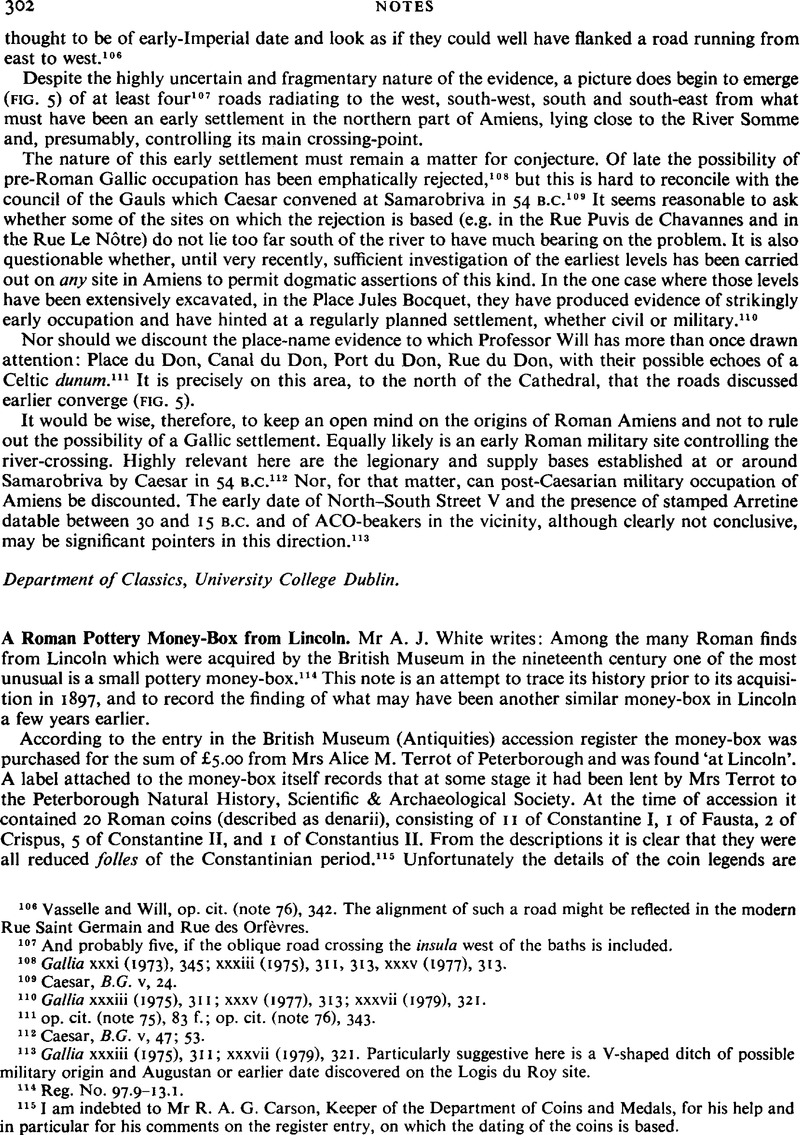Article contents
A Roman Pottery Money-Box from Lincoln
Published online by Cambridge University Press: 09 November 2011
Abstract

- Type
- Notes
- Information
- Copyright
- Copyright © Mr A. J. White 1981. Exclusive Licence to Publish: The Society for the Promotion of Roman Studies
References
114 Reg. No. 97.9–13.1.
115 I am indebted to Mr R. A. G. Carson, Keeper of the Department of Coins and Medals, for his help and in particular for his comments on the register entry, on which the dating of the coins is based.
116 Information from Mr R. A. G. Carson, and also from Miss C. Johns (Dept. of Prehistoric & Roman-British Antiquities).
117 With later money-pots it was customary to break off the top finial, or to smash the pot, in order to extract the coins.
118 In 1872 he wrote a List of the Lincolnshire Series of Tradesmen's Tokens and Town Pieces of the Seventeenth Century.
119 Proceedings of the Society of Antiquaries of London ii, 1st ser. (1849–1853), 292Google Scholar: I am most grateful to Professor Anne S. Robertson for this reference and for helpful discussion.
120 Associated Architectural Societies Reports and Papers 22 (1893–1894), lix.Google Scholar
121 The Illustrated London News, April 8th, 1848, p. 238.
122 e.g. ‘Tudor Green’ types, see P. Brears The English Country Pottery (1971), 24, 26; R. L. Hobson, Catalogue of the Collection of English Pottery in the British Museum (1903), nos. B178–85 and discussion there, and Seaby's Coin and Medal Bulletin (March, 1978), 75–6.
123 Acc. Nos. 53, 10–1, 1–12; 53, 11–8, 1; 66, 12–3, 1–219; 66, 12–8, 1–6; 67, 3–20, 1–85; 67, 3–30, 1–10.
124 Acc. No. 88.50 – a number of antiquities purchased by Mr J. O. Carlbom at Sotheby, Wilkinson & Hodge's sale, 5th February 1918 and lent, later given, to the Museum. Numerous other items from Trollope's collection later came to the City and County Museum via Trollope's daughters and Mr V. B. Crowther-Beynon.
125 Ross Mss. collection, Lincoln Vol II, in Lincolnshire Libraries Local History Collection.
126 Professor Anne S. Robertson has very kindly drawn my attention to two other Roman money-boxes (or hoard containers with slots in them); Silchester (Insula I, found c. 1894), a flask or bottle with a slot in its side containing 253 denarii, latest being of Severus. See T. May. The Pottery found at Silchester (1916), 118 and pl. xlix, no. 69; Grueber, H. A. in Fox, G. E., ‘Excavations on the site of the Roman City at Silchester, Hants, in 1894’, Archaeologia liv (1895), 455Google Scholar, and Boon, G., ‘A Hoard of Roman Coins found at Silchester’, Num. Chron xx, 6th ser. (1960), 241 ff.Google Scholar; and Nottingham, 1910, where one of two pots (one inverted inside the other) had a slot cut in its bottom, and contained a hoard to Antonius Pius and Marcus Aurelius: see Grueber, H. A., ‘A Find of Roman Coins at Nottingham’, Num. Chron x, 4th ser. (1910), 205–6.Google Scholar Foreign parallels for the Lincoln money-box have not been systematically searched. However a small mushroom-shaped pot with a slot in the upper edge containing 1st-3rd century A.D. coins was found at Cherchel in Algeria and is in the Greek and Roman Antiquities Dept. of the British Museum, acc. no. 1953.8–25.2.
- 2
- Cited by




